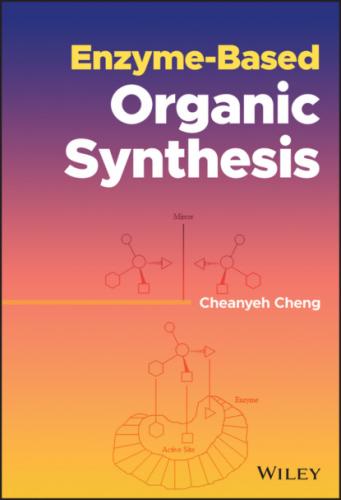Enzyme‐Based Organic Synthesis
Cheanyeh Cheng
Department of Chemistry
Chung Yuan Christian University
Chungli
Taiwan
This edition first published 2022
© 2022 John Wiley & Sons, Inc.
All rights reserved. No part of this publication may be reproduced, stored in a retrieval system, or transmitted, in any form or by any means, electronic, mechanical, photocopying, recording or otherwise, except as permitted by law. Advice on how to obtain permission to reuse material from this title is available at http://www.wiley.com/go/permissions.
The right of Cheanyeh Cheng to be identified as the author of this work has been asserted in accordance with law.
Registered Office John Wiley & Sons, Inc., 111 River Street, Hoboken, NJ 07030, USA
Editorial Office 111 River Street, Hoboken, NJ 07030, USA
For details of our global editorial offices, customer services, and more information about Wiley products visit us at www.wiley.com.
Wiley also publishes its books in a variety of electronic formats and by print‐on‐demand. Some content that appears in standard print versions of this book may not be available in other formats.
Limit of Liability/Disclaimer of Warranty In view of ongoing research, equipment modifications, changes in governmental regulations, and the constant flow of information relating to the use of experimental reagents, equipment, and devices, the reader is urged to review and evaluate the information provided in the package insert or instructions for each chemical, piece of equipment, reagent, or device for, among other things, any changes in the instructions or indication of usage and for added warnings and precautions. While the publisher and authors have used their best efforts in preparing this work, they make no representations or warranties with respect to the accuracy or completeness of the contents of this work and specifically disclaim all warranties, including without limitation any implied warranties of merchantability or fitness for a particular purpose. No warranty may be created or extended by sales representatives, written sales materials, or promotional statements for this work. The fact that an organization, website, or product is referred to in this work as a citation and/or potential source of further information does not mean that the publisher and authors endorse the information or services the organization, website, or product may provide or recommendations it may make. This work is sold with the understanding that the publisher is not engaged in rendering professional services. The advice and strategies contained herein may not be suitable for your situation. You should consult with a specialist where appropriate. Further, readers should be aware that websites listed in this work may have changed or disappeared between when this work was written and when it is read. Neither the publisher nor authors shall be liable for any loss of profit or any other commercial damages, including but not limited to special, incidental, consequential, or other damages.
Library of Congress Cataloging‐in‐Publication Data
Names: Cheng, Cheanyeh, author.
Title: Enzyme‐based organic synthesis / Cheanyeh Cheng, Department of Chemistry, Chung Yuan Christian University, Chungli, Taiwan.
Description: Hoboken, NJ : Wiley, 2022. | Includes bibliographical references and index.
Identifiers: LCCN 2021031980 (print) | LCCN 2021031981 (ebook) | ISBN 9781118027943 (hardback) | ISBN 9781118995143 (adobe pdf) | ISBN 9781118995150 (epub)
Subjects: LCSH: Enzymes–Synthesis. | Organic compounds–Synthesis. | Biocatalysis. | Enzymes–Biotechnology.
Classification: LCC TP248.E5 C44 2021 (print) | LCC TP248.E5 (ebook) | DDC 661/.805–dc23
LC record available at https://lccn.loc.gov/2021031980 LC ebook record available at https://lccn.loc.gov/2021031981
Cover Design: Wiley
Cover Image: Courtesy of author
Preface
The first time I was introduced to the field of microbiology was during the year 1982–1987, when I studied in the United States in the Department of Chemical & Biochemical Engineering of the Graduate and Professional School of Rutgers University to pursue my PhD degree. I was surprised that bacteria can live in an environment without air and at a temperature much higher than room temperature as well as ferment glucose to acetic acid. This study ignited my interest in the research of microorganisms and enzymes. As soon as I finished my PhD study in 1987, I came back to my alma mater, Chung Yuan Christian University, and worked as an associate professor in the Department of Chemistry, the place where I obtained my BS degree in 1974. I decided to continue my PhD research work to study the enzymatic cellulose hydrolysis for producing glucose using raw materials such as waste paper, dead tree branch, or waste bamboo chopsticks and the enantioselective bioreduction of ketones catalyzed by whole yeast cells for producing chiral secondary alcohols. I also taught a course called bioorganic chemistry, which focuses on the chemo‐, stereo‐, and regioselective enzyme or whole microbial cell catalyzed organic synthesis.
Ten years ago, I received an invitation from Wiley to write this book. At that moment I did not realize it is a big challenge for me to write a comprehensive book concerning enzyme‐catalyzed organic synthesis using six classes of enzymes. With the kind of courage that “the newborn calf is not afraid of tigers,” I accepted this invitation and wrote a book writing proposal. Fortunately, my proposal was approved by reviewers and I immediately started writing
